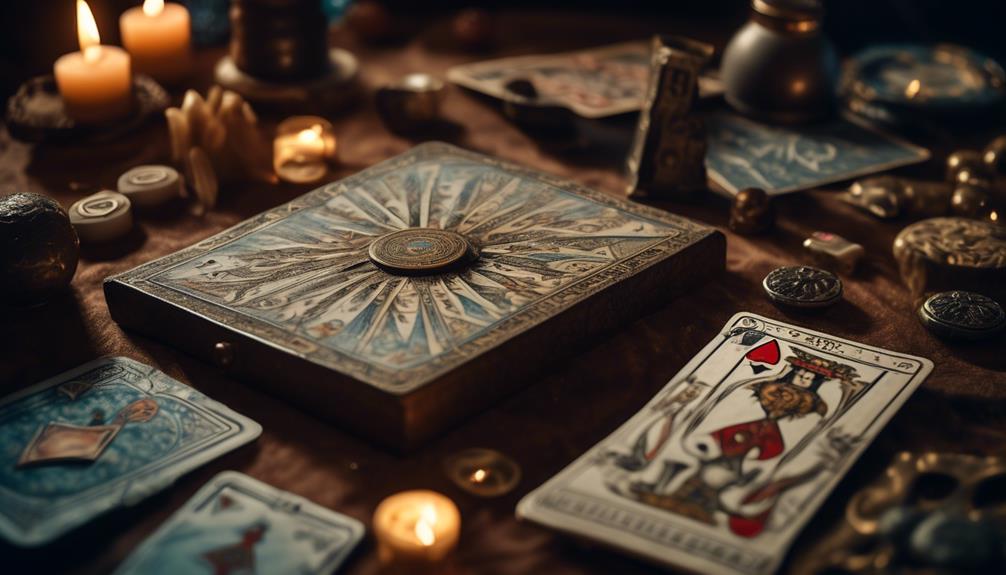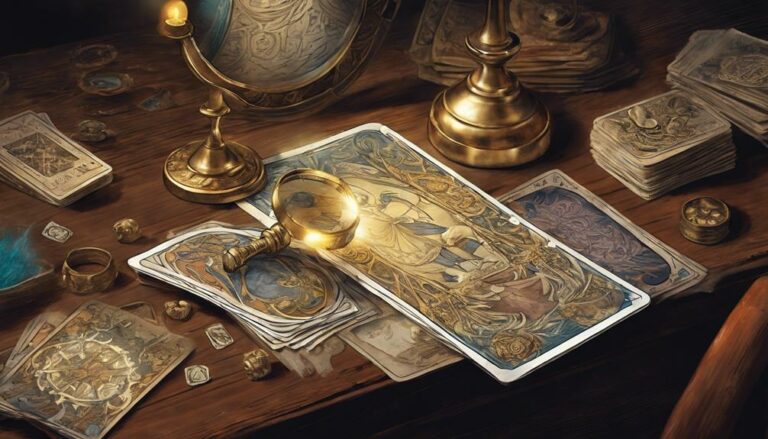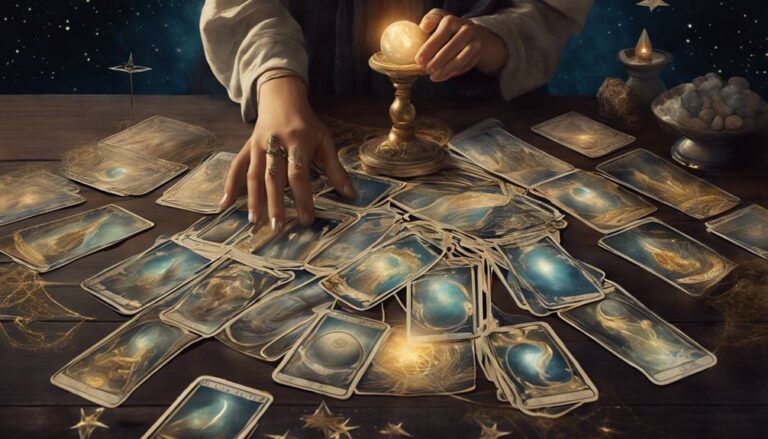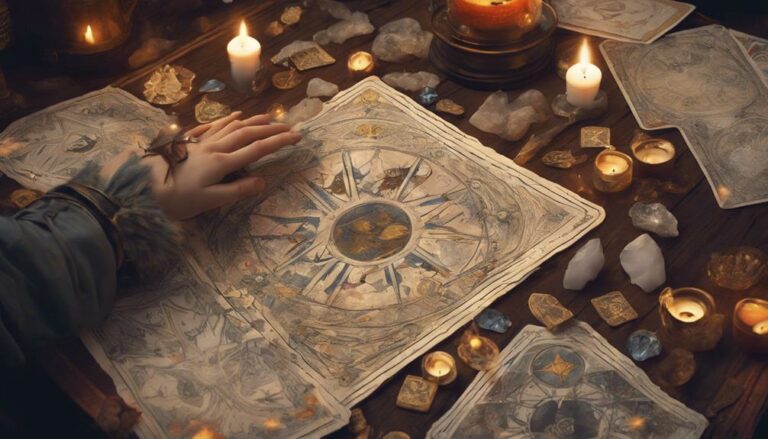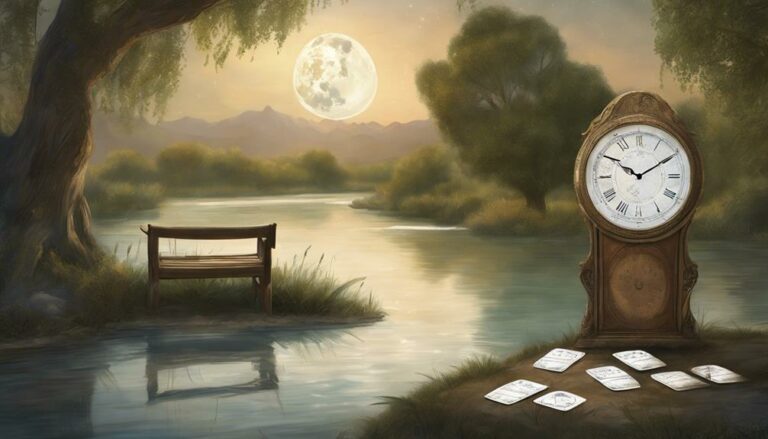When we consider the widespread use of the Tarot in Renaissance Europe, we’re not only encountering a tool for divination but a mirror reflecting the intricate web of cultural and spiritual beliefs of the time.
Our collective journey through the history of card divination reveals an intellectual tapestry, where symbols and archetypes are woven into the very fabric of society.
Table of Contents
We are aware, of course, that the allure of the Tarot extends beyond mere fortunetelling, having evolved into a sophisticated system for self-exploration and psychological insight.
As we explore the shifting sands of cultural acceptance and the controversies that have colored the perception of Tarot, we must also recognize the undeniable mark it has left on art, literature, and contemporary media.
It’s in these patterns of influence and transformation that the story of card divination truly unfolds, compelling us to question how deeply the cards reflect not only our destinies but our collective human experience.
Origins of Tarot Cards
Delving into the origins of tarot cards, we uncover a rich tapestry of history that begins in the 15th century with the creation of the Visconti Sforza pack. These early cards, which first appeared as hand-painted playing cards for Italian nobles, laid the groundwork for the Tarot de Marseille, one of the most influential tarot decks that continues to inspire tarot enthusiasts. The Tarot de Marseille solidified the structure of the tarot deck, particularly the Major Arcana, the cards representing life’s spiritual lessons and karmic influences.
Interest in tarot for divination, beyond their use as playing cards, gained momentum in the 18th century. It was Antoine Court de Gébelin who posited the idea that tarot cards held secret wisdom, linking them to ancient Egyptian lore. His intuitive interpretations opened the doors to the symbolic language of tarot that we’re familiar with today. While his theories were speculative, they were pivotal in shifting the view of tarot cards from mere entertainment to tools for introspection and guidance, thus shaping the path for their enduring cultural significance.
Tarot in Renaissance Europe
As we explore Tarot in Renaissance Europe, we find its roots deeply embedded in the period’s artistic and intellectual awakening. The rich symbolism within tarot imagery reflects the complex allegories and Renaissance beliefs about the cosmos and human existence.
Moreover, tarot’s connection to aristocratic circles showcases its role as both a pastime and an instrument for seeking guidance, long before its widespread use in divination.
Tarot’s Renaissance Beginnings
In the heart of the Renaissance, tarot cards emerged as a novel form of art and divination, with the Visconti Sforza pack marking one of the earliest known examples from 1450. These intricate cards offered insight into the human experience, crafting a rich tapestry of symbols that still captivate us today.
The Visconti Sforza tarot set the stage for the future of card divination.
Arthur Edward Waite and Pamela Colman Smith later revolutionized tarot with their iconic deck.
The Hermetic Order of the Golden Dawn influenced tarot’s mystical aspects, including the structure of the minor Arcana.
We understand these origins as a blend of art, spirituality, and psychology, shaping the tarot’s journey into modernity.
Symbolism in Tarot Imagery
We explore how the rich tapestry of symbols within tarot imagery reflects the diverse spiritual and cultural currents of Renaissance Europe. The High Priestess card, for instance, embodies deep symbolic meaning, representing wisdom and hidden knowledge. It echoes the period’s fascination with the mystical and the secretive.
Meanwhile, the Death card, often misunderstood, signifies transformation and change rather than literal demise, mirroring the era’s philosophical views on life’s transitory nature.
Each card in the Rider-Waite-Smith deck, a pivotal contribution to tarot’s evolution, is laden with allegory and significance, resonating with seekers of insight. The four suits, reminiscent of playing cards, align with societal structures, offering a window into the customs and values that shaped Renaissance thought and practice.
Through these images, we gain a nuanced understanding of historical perspectives on destiny and self-reflection.
Tarot’s Aristocratic Associations
Tarot’s journey into aristocratic salons of Renaissance Europe marked its transformation from a mere card game to a sophisticated system of divination. As we delve into this rich period, we uncover intriguing facets:
- The *Carte à Jouer* evolved into tarot cards, bearing intricate symbolism favored by the elite.
- Aristocratic associations with the tarot are evident, as the first written instructions for tarot divination were likely produced within the confines of a secret society.
- The Visconti Sforza deck, a paragon of craftsmanship, reflects the opulent tastes and intellectual pursuits of nobility.
We recognize tarot’s storied past, appreciating how aristocratic influence shaped its mystique, turning it into a tool for insight that continues to fascinate us today.
Occult Revival and Tarot
As we explore the Occult Revival, we find that tarot cards underwent a Mystical Renaissance, where esoteric knowledge was infused into the imagery of the cards. This period saw the intertwining of ancient wisdom and the art of card divination, as each deck started to bear symbols laden with deeper, hidden meanings.
It’s these rich layers of symbolism that invite us to consider how the tarot became a mirror reflecting the esoteric currents of the time.
Tarot’s Mystical Renaissance
During the late 19th and early 20th centuries, tarot experienced a mystical renaissance, intertwining with the period’s broader occult revival to transform the practice into a profound tool for personal and spiritual insight. We’ve witnessed a fascinating evolution in the ART OF READING tarot decks, as this period gave rise to influential figures and decks that have shaped modern perceptions of tarot.
- Aleister Crowley introduced the Thoth Tarot, infusing the cards with esoteric symbolism and depth.
- The Waite-Smith Tarot brought forth a visual language that democratized the knowledge previously held by few.
- Mystical renaissance of tarot bridged the gap between divination and psychological insight, making it a holistic practice.
These developments enriched the tapestry of tarot’s cultural significance, solidifying its role in the sphere of the mystical and metaphysical.
Esotericism in Card Imagery
The occult revival breathed new life into card imagery, as esoteric symbols and hidden meanings became keystones in the practice of tarot divination. We’ve seen tarot decks evolve with this esotericism, weaving complex narratives that draw seekers into a world where intuition meets history.
The book of Thoth, often associated with the mysteries of ancient Egypt, has deeply influenced modern interpretations of tarot, instilling a sense of the arcane in each card.
Jean-Baptiste Alliette, a pivotal figure in the history of tarot, crafted the first tarot deck with the specific intention of divination. His work, alongside the traditions of French, British, and Tarologue, underscores a rich tapestry of cultural exchange and the transformative power of esoteric knowledge in card divination.
Tarot Symbolism and Art
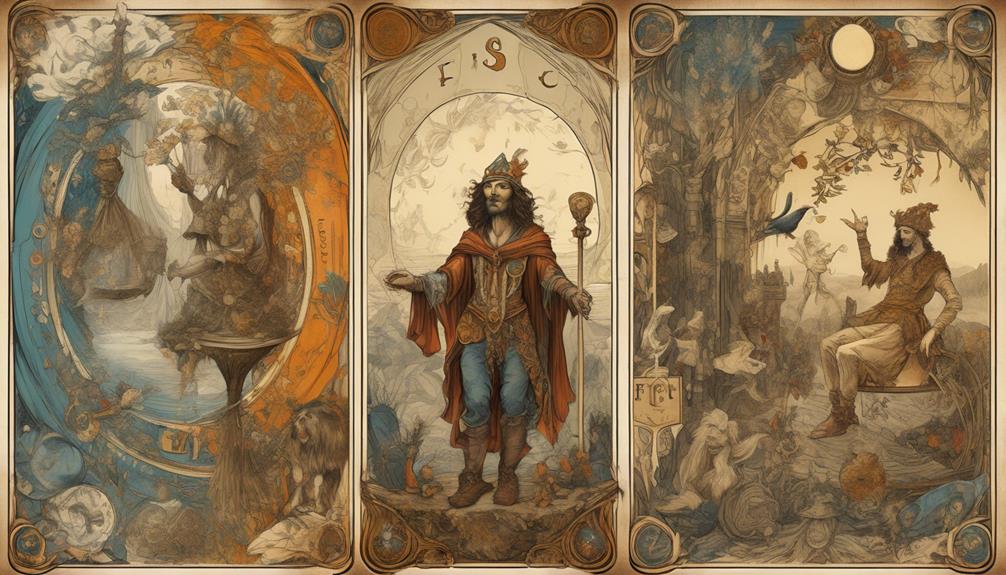
Delving into the rich tapestry of tarot symbolism and art, we uncover a visual language that has captivated and intrigued practitioners across the ages. The imagery of each tarot deck is a gateway to understanding deeper truths, with symbols that resonate with our collective consciousness. This symbology forms a bridge between our world and the more abstract realms of intuition and spirituality.
Through the lens of tarot symbolism, we see:
- The Marseille Tarot, with its traditional iconography as exemplified by decks like Jean Noblet’s, which anchors us in the historical roots of tarot.
- The Rider-Waite-Smith deck, which revolutionized tarot art by depicting full scenes with rich symbolic meanings, facilitating a deeper intuitive connection for readers.
- The innovative spreads and symbolic layers introduced during the French tradition, enhancing the esoteric dimensions of tarot beyond its origins as a card game.
The merger of artistry and intuition in tarot decks such as the Rider-Waite-Smith hasn’t only created a surge in its popularity but has also empowered individuals, particularly women, in areas like psychology. Tarot symbolism thus becomes a tool for self-discovery, allowing us to tap into the subconscious and bring forth insights that were previously shrouded in mystery.
Tarot’s Societal Perceptions
Exploring tarot’s societal perceptions reveals a dichotomy where it’s celebrated for its mystical allure and yet often dismissed as mere superstition. Throughout cultural history, tarot has fascinated many with its enigmatic symbolism and potential for self-discovery. Yet, society called into question its legitimacy, frequently relegating it to the fringes of serious intellectual discourse.
Informed by the French and British traditions, as well as the tarologue approach, card readers have cultivated a rich and varied practice. This diversity reflects the adaptability of tarot to different cultural contexts and personal beliefs. The tarologue tradition, in particular, challenges the notion that cards hold fixed meanings, underscoring the role of interpretation in relation to the context and the querent’s question.
Despite skepticism, figures like Pamela Colman Smith contributed to tarot’s commercial success, securing its place in modern spiritual exploration. The work of scholars such as Michael Dummett helped to illuminate tarot’s historical significance, providing a framework for understanding its evolution and influence.
As we delve into tarot’s place in society, we acknowledge its complex identity—a tool for introspection, an art form, and an emblem of esoteric knowledge. Our perspective is both informed and intuitive, honoring tarot’s multifaceted history and its enduring impact.
Tarot in Literature and Film
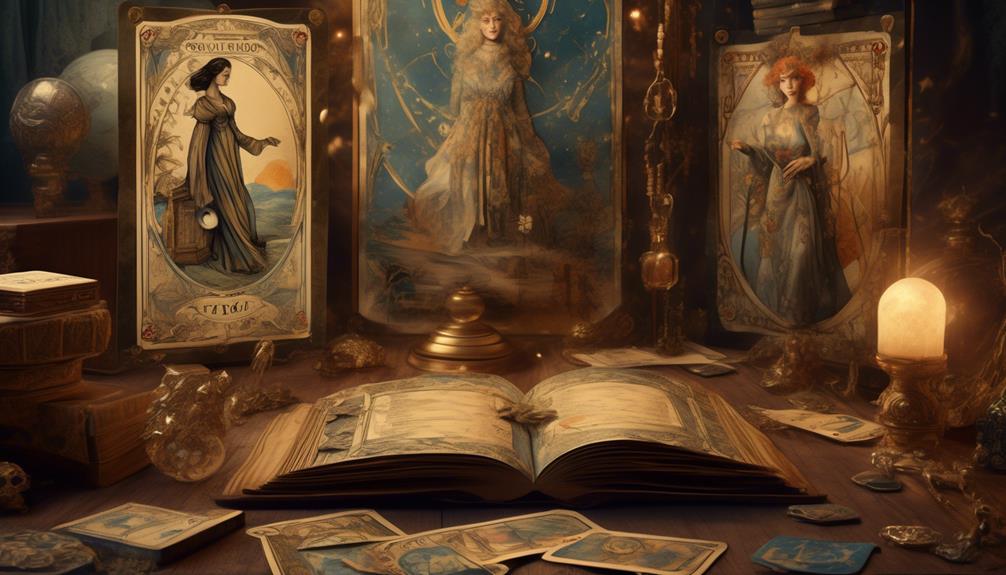
Literature and film’s embrace of tarot has woven a rich tapestry of intrigue and foresight into the fabric of storytelling. We’ve seen characters grapple with the symbolism of tarot decks, using them to navigate through their fictional worlds. The cards often serve as a mirror reflecting the internal struggles and future paths of those who seek their wisdom.
The depiction of tarot in these mediums has truly sparked a widespread fascination. To paint a picture:
- In literature, we find characters reaching for a deck of Rider-Waite-Smith or Grand Etteilla cards to perform a reading, seeking answers in moments of uncertainty.
- On film, a mysterious figure lays out the reading cards, each turn revealing a piece of the narrative puzzle that captivates audiences.
- Throughout both, the tarot’s iconic imagery serves as visual shorthand for destiny and the supernatural, evoking a sense of the mystical in scenes brimming with tension and possibility.
As we explore these portrayals, we’re reminded that the tarot’s role in culture isn’t just one of prediction but also one of profound storytelling. It’s a tool that has, and continues to, inspire narratives that resonate with our desire for understanding the unknown.
Modern Tarot Practices
In our journey through the evolution of tarot, we’ve arrived at the diverse landscape of modern tarot practices, where ancient traditions meet contemporary interpretations. Influential tarot decks like the Rider-Waite-Smith have paved the way for a myriad of modern decks, each offering unique artistic visions while preserving symbolic meanings.
The Rider-Waite-Smith tarot, produced by US Games, remains a cornerstone in how we read the cards today, setting standards for imagery and symbolism that facilitate intuitive readings.
Many of us are drawn to tarot as a spiritual practice, seeking guidance from a higher power or using the cards as a focus during prayer. The commercial success of tarot decks has also expanded their use beyond traditional fortune-telling. Now, we utilize these cards for spirit evocation, invocation, and even household spells, reflecting tarot’s integration into various aspects of contemporary life.
The Tarologue tradition reminds us that the cards’ meanings aren’t fixed; rather, they gain significance from the context and the questions posed. This insight challenges us to engage deeply with the cards, ensuring that modern tarot practices remain a dynamic and evolving form of personal and spiritual expression.
Tarot’s Psychological Implications
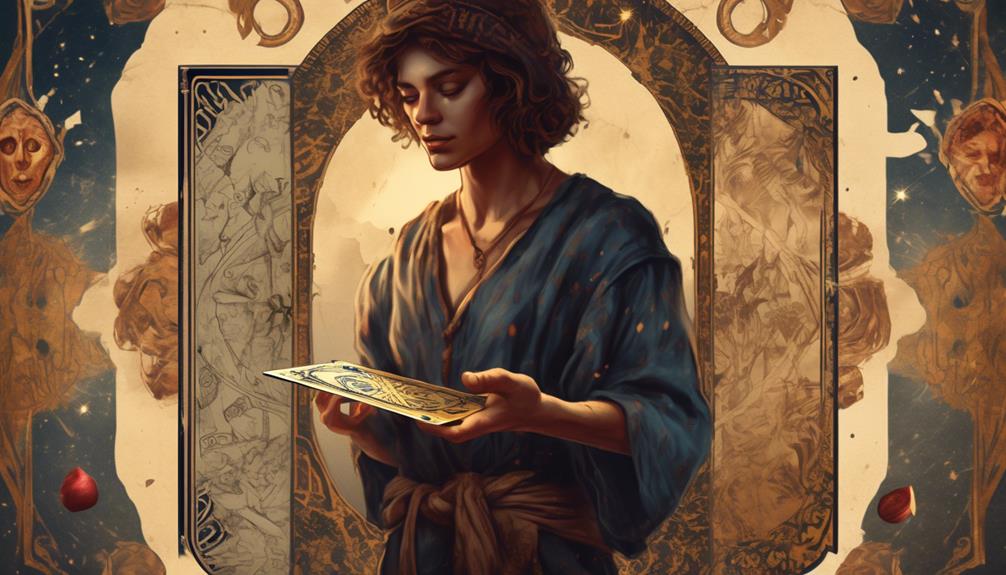
As we consider the role of tarot in spiritual practices, it’s equally important to recognize how these cards serve as powerful tools for psychological introspection and understanding. Tarot decks, with their rich tapestry of images and symbols, unlock aspects of our psyche in ways few other tools can. The psychological implications of tarot are profound, offering a mirror to our innermost thoughts, fears, and desires.
The Rider-Waite-Smith deck, with its detailed illustrations, allows for deep psychological exploration through universally recognized archetypes.
Jean-Baptiste Alliette, also known as Etteilla, played a pivotal role in establishing tarot’s divinatory traditions, which significantly contributed to the psychological relevance of tarot interpretation.
The imagery and symbolism within tarot are designed to resonate with the subconscious, revealing insights that might elude the conscious mind.
Tarot’s psychological implications extend beyond mere divination; they offer a form of therapy, a silent conversation between the individual and the deeper self. Historical and cultural contexts have shaped these implications, imbuing each card with a narrative that reflects collective and personal human experiences.
We’re not just engaging in a practice of foretelling futures but embarking on a journey of self-discovery, with the cards as our guide.
Frequently Asked Questions
When Were Tarot Cards First Used for Divination?
We’re fascinated by when tarot cards began to hold mystical symbolism beyond their playing origins. It was during the Renaissance connection that their artistic evolution prompted a divinatory shift.u003cbru003eSpecifically, it’s believed that tarot cards were first used for divination in the 18th century. Their rich imagery and symbolism became tools for insight, reflecting an intuitive understanding that transcends mere games, speaking to life’s deeper questions and paths.
Where Did the Tarot Card Reading Come From?
We’ve learned that tarot card reading has mystical origins, likely emerging from ancient practices. It’s a blend of cultural integration and symbolic interpretation, deeply rooted in esoteric traditions.u003cbru003eWhile the precise birthplace remains elusive, it’s clear that these practices reflect a rich tapestry of historical insights, evolving to meet the spiritual and introspective needs of countless individuals seeking guidance throughout the centuries.u003cbru003e
What Cards Are Used for Divination?
We use tarot and playing cards for divination, tracing playing cards’ history as they evolved from games to mystical tools.u003cbru003eOracle decks’ evolution brought us the Lenormand cards, introducing new symbolism in cartomancy.u003cbru003eWe distinguish between divination and gambling, recognizing the profound meanings behind the symbols.u003cbru003eIn seeking guidance, we’re respectful of cartomancy’s complexities, engaging with an intuitive style that welcomes those yearning for understanding.
Why Is Tarot Divination?
We’re exploring tarot divination because it’s entwined with mystical symbolism and touches on divination ethics. It’s driven by psychic intuition and shapes cultural perceptions.u003cbru003eThrough tarot, we perform archetypal analysis, unlocking insights into our psyche. We respect the practice’s depth and aim to convey its essence to those seeking understanding, while remaining mindful of the diverse perspectives surrounding this intriguing form of self-reflection and foresight.

